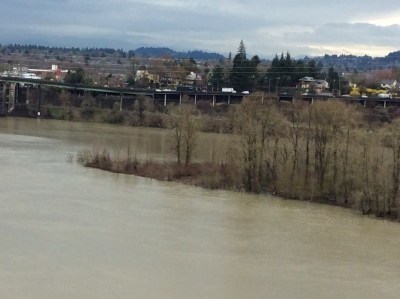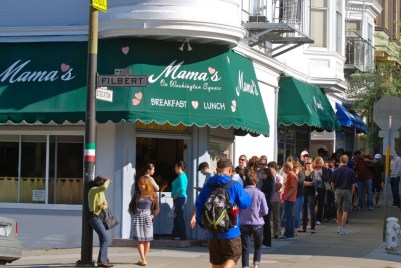A little less of Ross Island visible…




George’s slightly off-center view of the world
Places I remember
 Highway 99 traverses the Pacific Coast from the Canadian border, at Blaine Washington, to Mexico, at Calexico California. Upon completion of Interstate 5 in 1972, 99 lost its designation as a “U.S.” highway. Much of it is now labeled State Route 99 in California, Oregon Route 99 – splits into 99E and 99W from Junction City, near Eugene, to Portland – and SR-99 in Washington. (It continues as Highway 99 in British Columbia.)
Highway 99 traverses the Pacific Coast from the Canadian border, at Blaine Washington, to Mexico, at Calexico California. Upon completion of Interstate 5 in 1972, 99 lost its designation as a “U.S.” highway. Much of it is now labeled State Route 99 in California, Oregon Route 99 – splits into 99E and 99W from Junction City, near Eugene, to Portland – and SR-99 in Washington. (It continues as Highway 99 in British Columbia.)
With decertification came loss of identifying signage. There never really was any definitive identifier informing a motorist when crossing the unofficial border between northern and southern California. As you travel the highway, keep an eye out for the pine tree and palm tree adjacent to each other in the median between northbound and southbound lanes. It’s a few miles north of Fresno, at about milepost 150. The fir represents the northern sector of the state; the palm tells you are in southern California. Your GPS won’t tell you this.
If you feel the urge to travel historic 99, you’ll want That Ribbon of Highway guidebooks.

“They were all impressed with your Halston dress
And the people that you knew at Elaine’s”
– Billy Joel, “Big Shot“
They’re pretty good, but the best hamburgers actually are at the Nob Hill Bar & Grill in Portland Oregon. Really. But no Chinese food at Nob Hill.
 Perusing the bill after enjoying a meal in a San Francisco restaurant, you will likely see an additional charge, usually itemized below the sales tax, for “SF Mandate” or “Employee Mandate.” The charge could be 4% of the total tab, or 5% or 6%. Or a flat charge of $1.50 or $2.00 per diner. Or maybe there is no additional charge. The city of San Francisco requires businesses with twenty or more employees to provide heath coverage. This is so distasteful to restaurant operators, who value their workers so little and are so resentful of compensating them, they put the cost as a separate charge on the bills.
Perusing the bill after enjoying a meal in a San Francisco restaurant, you will likely see an additional charge, usually itemized below the sales tax, for “SF Mandate” or “Employee Mandate.” The charge could be 4% of the total tab, or 5% or 6%. Or a flat charge of $1.50 or $2.00 per diner. Or maybe there is no additional charge. The city of San Francisco requires businesses with twenty or more employees to provide heath coverage. This is so distasteful to restaurant operators, who value their workers so little and are so resentful of compensating them, they put the cost as a separate charge on the bills.
 San Francisco detective Frank Bullitt got crossways with ambitious politician Walter Chalmers over the murder of a crucial organized-crime witness under the detective’s protection. Oh, okay, this didn’t really happen. It was a 1968 movie, “Bullitt,” with Steve McQueen in the title role. Lone eagle Bullitt refused to be part of Chalmers’s (Robert Vaughn) machinations. The movie also featured what many aficionados consider the greatest car chase ever filmed.
San Francisco detective Frank Bullitt got crossways with ambitious politician Walter Chalmers over the murder of a crucial organized-crime witness under the detective’s protection. Oh, okay, this didn’t really happen. It was a 1968 movie, “Bullitt,” with Steve McQueen in the title role. Lone eagle Bullitt refused to be part of Chalmers’s (Robert Vaughn) machinations. The movie also featured what many aficionados consider the greatest car chase ever filmed.
Steve McQueen himself drove the fastback Mustang, chasing bad guys in a Dodge Charger to their fiery end. (No stunt driver for McQueen. He also gave us the greatest movie motorcycle chase.) The iconic Mustang disappeared shortly after filming ended. McQueen reportedly wanted to buy it, but it could not be found. The car recently turned up in a Mexican junkyard. No one knows where it has been for the last forty-nine years or why it was in Mexico. Experts claim the VIN confirms it is the authentic car. Estimates are that the car, when restoration is finished, could have a value in excess of a million dollars.
 Emma Stone and Ryan Gosling’s characters shared a tender “La La Land” moment inside an Angels Flight cable car. The real-life Angels Flight is decidedly less romantic. The funicular railway travels 300 feet up Bunker Hill at a thirty-three-degree angle from downtown Los Angeles. Traveled, that is.
Emma Stone and Ryan Gosling’s characters shared a tender “La La Land” moment inside an Angels Flight cable car. The real-life Angels Flight is decidedly less romantic. The funicular railway travels 300 feet up Bunker Hill at a thirty-three-degree angle from downtown Los Angeles. Traveled, that is.
The funicular cable cars originally opened in 1901 and ran until 1969. It reopened in 1996, then closed in 2001 after a fatal accident. It has operated off and on since 2010. It suffered a derailment in 2013 and has been out of service since. The trash and graffiti were not visible in the movie scene, purportedly filmed without the knowledge of the L.A. utilities commission. Angels Flight is being renovated and will supposedly open again by Labor Day… not like the Fenelon Place Elevator that has been in continuous service since 1893.
Next time you are in Dubuque Iowa, after you’ve eaten your loose-meat sandwich and breaded pork tenderloin, find your way to Fourth Street and take an excursion on the Fenelon Place Elevator. Don’t worry, the trip will not cause you any digestive distress; it’s a gentle ride. Former mayor and former state senator J. K. Graves built the incline railway in 1882, for his private use to transport him between his home at the top of the hill and his bank downtown. Two years later, he took passengers at a nickel a ride. In the midst of a recession, Mr. Graves gave the newly-formed Fenelon Place Elevator Company the franchise to use the track’s right of way.
It now costs $3.00 round trip for the 296-foot ride up the 189-foot hill. At the top you’ll have a panoramic view of downtown Dubuque and the Mississippi River.